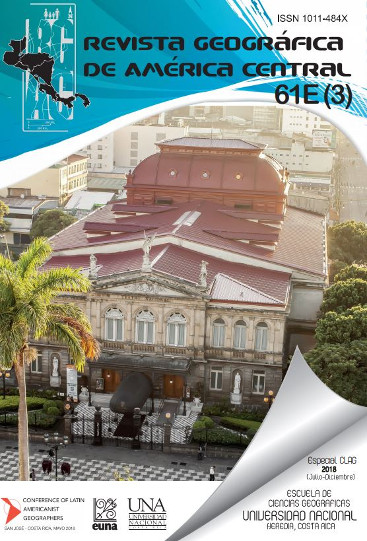Portuguese Origins of a 16th Century Aqueduct in México
DOI:
https://doi.org/10.15359/rgac.61-3.24Palavras-chave:
Mexico, Madeira, landscapes, aqueducts, technology transfersResumo
Many aqueducts built during the Spanish colonial era remain standing in México, albeit not functioning. A few date to the 16th century. Some of these early aqueducts are quite spectacular and highly visible. Others are small and are located in places not easily found. Despite their size, small aqueducts are important for understanding knowledge pertaining to technology transfers from the Old World to the New. One such aqueduct is on the property of the Hacienda de Pacho, near Xalapa in the state of Veracruz. One of its highly unusual characteristics is that its construction involved Gothic arches. No other colonial aqueduct in México has such features. According to documentary courses dating to AD 1591, it was built by the hacienda’s original owner who was from the Portuguese island of Madeira. This paper reports on field activities involved in verifying the Maderian origins of this unique aqueduct.
Referências
Cambrezy, L. & Lascuráin, B. (1992). Crónicas de in territorio fraccionado de la hacienda al ejido (Centro de Veracruz). México: Ediciones Larousse.
Chelmicki, J. C. C. de (2008). Memória sobre o Aqueducto Geral de Lisboa feita por ordem do Ministério das Obras Públicas em portaria de 15 de Fevereiro de 1856.
Lisboa, Portugal: EPAL—Empresa Portuguesa das Águas Livres.
Crespo, H. (1988). Historia del Azúcar en México. 2 vol. México: Fonda de Cultura,Económica, e Azúcar, S.A.
Gouveia, D. F. de (1985). O Açucar de Madeira: A Manufactura Açucareira Madeirense (1420-1500), En: Atlantico [Funchal] 4, 260-272.
Greenfield, S. (1977). Madeira and the Beginnings of New World Sugar Cane Cultivation and Plantation Slavery: A Study in Institutional Building. En: Annals of the New York Academy of Sciences 292(4), 536-552.
Håkansson, N. T. & Widgren, M., eds. (2014). Landesque Capital: The Historical Ecology of Enduring Landscape Modifications. Walnut Creek, USA: Left Coast Press.
Hillman Chapoy, I. (2007). La Hacienda de Nuestra Señora de los Remedios también conocida como Hacienda de Pacho. Unpublished manuscript on file at Hacienda de Pacho.
Patel, R., & Moore, J.W. (2017). A History of the World in Seven Cheap Things: A Guide to Capitalism, Nature, and the Future of the Planet. Los Angeles, USA: University of California Press.
Stevens-Acevedo, A. R. (2013). The Machines that Milled the Sugar-Canes: The Horizontal Double Roller Mills in the First Sugar Plantations of the Americas. Unpublished paper on File at the Dominican Studies Institute, City College of New York, USA.
Underwood, J. & P. (2005). Landscapes of Madeira: A Countryside Guide. London, UK: Sunflower Books.
Valdes, O. (1961). El Padre Tembleque. México: Biblioteca Enciclopidica del Estada de México.
Viera y Clavijo, J. de (1991). Historia de Canarias, Las Palmas de Gran Canaria, España: Viceconsejería de Cultura y Deportes, Gobierno de Canarias.
Vieira, A. (2004). “Sugar Islands: The Sugar Economy of Madeira and the Canaries, 1450- 1650,” Tropical Babylons: Sugar and the Making of the Atlantic World, 1450-1680, Chapel Hill, USA: The University of North Carolina Press (pp. 42-84).
Downloads
Publicado
Como Citar
Edição
Seção
Licença
Política proposta para revistas que oferecem Acesso Aberto
Os autores que publicam nesta revista concordam com os seguintes termos:
a. Os autores mantêm os direitos autorais e garantem à revista o direito de ser a primeira publicação do trabalho, sob a Licença Creative Commons https://creativecommons.org/licenses/by-nc-sa/4.0/deed.es, que permite que outros compartilhar com reconhecimento da autoria do trabalho e da publicação inicial nesta revista.
b. Os autores podem estabelecer separadamente acordos adicionais para a distribuição não exclusiva da versão do trabalho publicado na revista (por exemplo, colocá-la em repositório institucional ou publicá-la em livro), com reconhecimento de sua publicação inicial nesta revista. Esses acordos adicionais devem respeitar os termos da licença: ou seja: não envolver lucro e compartilhar com a mesma licença.
c. Os autores são incentivados a arquivar a versão/PDF pós-impressão ou do editor em repositórios de acesso aberto.







 REVGEO está licenciado sob https://creativecommons.org/licenses/by-nc-sa/4.0/deed.es
REVGEO está licenciado sob https://creativecommons.org/licenses/by-nc-sa/4.0/deed.es
.svg_4.png)

_(1).png)
_(1)_(1)_(1)_1.png)
(2)(1)(1)(1).png)
